What Are the Goals and Costs of
Designing Self-Paced eLearning?
by Adele Sommers
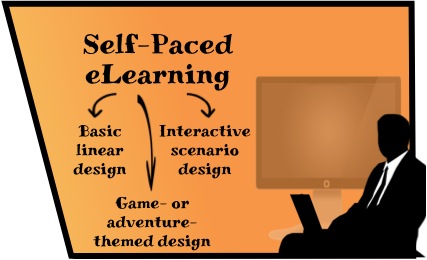 What would many people name as the thing they love best about taking self-paced eLearning courses — mainly if they can do it from home? What would many people name as the thing they love best about taking self-paced eLearning courses — mainly if they can do it from home?
It’s the ability to participate in their “bunny slippers” at any hour of the day or night!
That’s because eLearning blends a delivery method and training modality that lets participants partake in learning at their own pace, whenever it’s convenient.
But is all eLearning alike? People weighing whether to pursue their first eLearning project might not realize that there is more one type, and therefore, more than one way to create it. Multiple eLearning “flavors” exist, which fall into three core groups:
Level 1: Basic linear design
Level 2: Interactive scenario design
Level 3: Game- or adventure-themed design
Let’s explore each of these three levels, next, as well as how long it takes and how much it costs, on average, to produce each one.
Level 1: Basic Linear Design
Level 1, basic linear design, is the simplest eLearning model. This level consists mainly of slides, text, graphics, possibly basic audio and stock video, and perhaps quiz or test questions. It usually involves a fixed, sequential progression, as shown in this iconographic view:

If you are looking to make good reuse of instructor-led training, this could be a cost-effective way to do it. These are some of the most common approaches:
- You can turn a slide deck from classroom-based training into Level 1 eLearning using specialized authoring systems and conversion tools. If you incorporate a few key optional elements, such as a narration sound track, a navigation scheme to help learners move around, and assessment(s), as applicable, you can create very usable, albeit basic, self-paced training.
- You can record a Web seminar (webinar) as the instructor delivers it live. Webinars are usually slide-based presentations that can be recorded during delivery, so the instructor’s narrative is included. Those recordings can then be posted online for learners to access in a self-paced viewing mode.
How Long Does Level 1 eLearning Take to Create?
In 2010, the Chapman Alliance published a comprehensive research study* on how long it takes to design and develop one hour of finished self-paced training, from the simplest type (in the low-range category) to the most complex (in the high-range category). Level 1, basic linear design, is usually the least expensive method of producing eLearning, as explained in the categories below. Note that handouts or workbooks, if used, may entail additional development time.
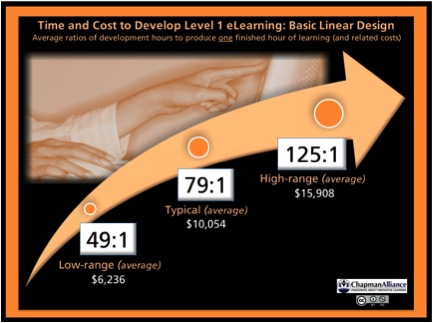 Low-range: This type often entails specialized authoring systems, such as slide-deck conversion tools designed to work with pre-existing slides, to produce simple eLearning. It requires an average of 49 hours to put out a one-hour module (or about $6,236, based on the per-hour cost of “typical” productions). Click the image to enlarge. Low-range: This type often entails specialized authoring systems, such as slide-deck conversion tools designed to work with pre-existing slides, to produce simple eLearning. It requires an average of 49 hours to put out a one-hour module (or about $6,236, based on the per-hour cost of “typical” productions). Click the image to enlarge.
Typical: This is the norm for corporate Level 1 eLearning. It entails rapid development or slide deck conversions, and may add some narration and video media. It requires an average of 79 hours to produce a one-hour module (or about $10,054).
High-range: This type usually involves more complex projects that are more difficult to produce, such as courses that include an abundance of narration and video media to depict detailed procedural instruction, for example. It requires an average of 125 hours to produce a one-hour module (or about $15,908, based on the per-hour cost of a “typical” production).
__________________________________________
*Data source for all of the time and cost estimates:
Chapman, B. (2010). How Long Does It Take to Create Learning? [Research Study]. Published by Chapman Alliance LLC, available from chapmanalliance.com. Image was used and adapted with permission. The data contained in this research was collected from 249 organizations, representing 3,947 learning development professionals, who have created classroom-based and eLearning content that has been consumed by 19,875,946 learners.
Level 2: Interactive Scenario Design
Level 2, interactive scenario design, is a more complex eLearning model. This approach supports learning through discovery, and includes stories, scenarios, and case studies. Whenever training situations involve highly conditional problem solving and the need to make judgments on the fly, scenario-based learning (SBL) is usually more effective than a linear, lecture-based approach. (This article by instructional-design expert Dr. Ruth Clark gives more background on this subject.)
Scenarios in eLearning offer opportunities for interaction that go beyond what is possible in a classroom setting. In story-based eLearning, learners branch through a series of scenes based on their choices. They typically work through ambiguous situations that require judgments, trouble-shooting, and nuanced decision making. For example, scenarios might challenge learners to make thoughtful selections in response to dangerous situations, legal or company policy matters, health issues, complex problems, attitudes and behaviors, and more.
A key aspect of this type of eLearning is the feedback it should give to learners on the viability of their choices. Feedback might be direct or it might be implied by the consequences, as in this story about “Bob’s Presentation Adventures”:
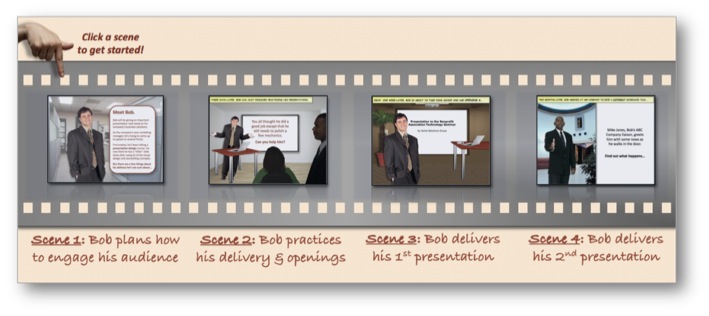 For these reasons, scenarios are considered to be an industry best practice for helping learners analyze the tradeoffs of complicated choices, especially if they assume the role of advisor or decision maker in a challenging discovery process! For these reasons, scenarios are considered to be an industry best practice for helping learners analyze the tradeoffs of complicated choices, especially if they assume the role of advisor or decision maker in a challenging discovery process!
How Long Does Level 2 eLearning Take to Create?
In contrast to Level 1, Level 2 eLearning adds at least 25% more interactive elements to support discovery activities. It also makes much more liberal use of multimedia, such as narration audio, video, and animations, as explained below.
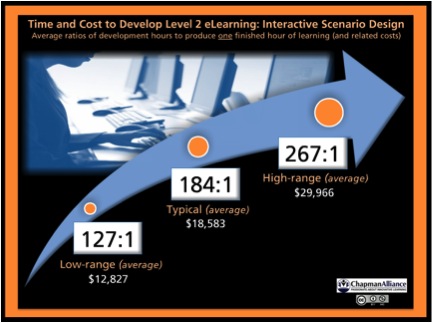 Low-range: This type often involves some sort of rapid development using template- based interactions, and may embody basic audio, video, and animations. It requires about 127 hours to create a one-hour module (or about $12,827, based on average per-hour costs of “typical” productions). Click the image to enlarge. Low-range: This type often involves some sort of rapid development using template- based interactions, and may embody basic audio, video, and animations. It requires about 127 hours to create a one-hour module (or about $12,827, based on average per-hour costs of “typical” productions). Click the image to enlarge.
Typical: This is the norm for corporate Level 2 eLearning. It may use a combination of template-based and custom- designed interactions, as well as some audio, video, and animations. It requires an average of 184 hours (or about $18,583) to produce a one-hour module.
High-range: This type involves more complex projects that incorporate advanced and custom-designed interactions, embedded simulation activities, and abundant audio, video, and animations. It requires about 267 hours to produce a one-hour module (or about $29,966, based on the per-hour cost of a “typical” production).
Level 3: Game- or Adventure-Themed Design
In contrast to Levels 1 and 2, Level 3 is highly interactive and challenging, often involving complex simulations or serious gaming. Like Level 2, it supports learning through discovery, but in a more sophisticated and comprehensive way.
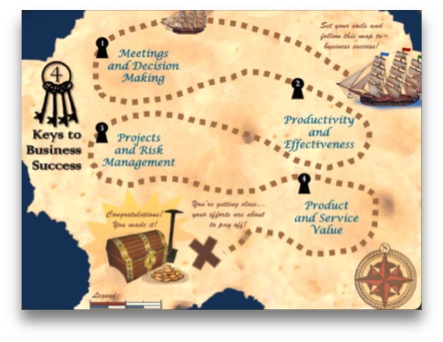 Level 3 is deeply immersive and intensively multimedia-oriented. The game designs often incorporate features such as avatars and custom interactions. Level 3 is deeply immersive and intensively multimedia-oriented. The game designs often incorporate features such as avatars and custom interactions.
The simulations and games offer learners realistic and incentivizing challenges, commonly using points and scores to reward learners.
For these reasons, Level 3 typifies the most complex and time-consuming form of eLearning to develop.
How Long Does Level 3 eLearning Take to Create?
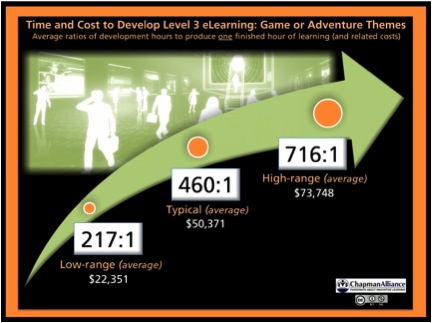 Low-range: This type often involves rapid development that may use template-based interactions, simulations, and games, as well as efficient simulation design practices. It requires about 217 hours to create a one-hour module (or about $22,351, based on the per-hour cost of a “typical” production). Click the image to enlarge. Low-range: This type often involves rapid development that may use template-based interactions, simulations, and games, as well as efficient simulation design practices. It requires about 217 hours to create a one-hour module (or about $22,351, based on the per-hour cost of a “typical” production). Click the image to enlarge.
Typical: This is the norm for Level 3 corporate eLearning. It often combines template- based and custom-designed interactions, games, and simulations involving audio, video, and animations. An average of 460 hours is needed to produce a one-hour module (about $50,371).
High-range: These highly complex projects frequently embody advanced learning simulations and games. Such high-end productions often include extensive audio, video, and animations. An average of 716 hours is required to produce just one hour (or about $73,748, based on the per-hour cost of a “typical” production). Even more complex projects involve an excess of 2,000+ hours of development time per finished hour.
In conclusion, which eLearning model should we choose? The selection we make should depend on the subject matter, the needs and characteristics of the target audience, and available time, resources, and budget. Because time and cost tradeoffs sometimes require us to simplify our approach to manage with a smaller budget or shorter schedule, the more complex models (Levels 2 and 3) may not be feasible even if they are warranted. However, with creative planning, it might be possible to begin with Level 1 and phase in Level 2 or 3 functionality over time!
For additional ideas, you might want to refer back to:
Stay tuned for the final segment, in which we will explore blended learning!
Copyright 2014 Adele Sommers
|


